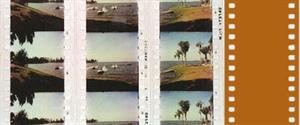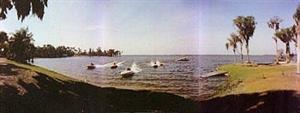What is Cinerama?
3-Projector Cinerama
In the 1930s Fred Waller, a motion picture engineer at Paramount, sought to create the illusion of reality on the screen. After years of experiments, he developed a system that used three cameras with a single shutter to film an area 146 degrees wide by 55 degrees high, approximately the scope of the human eye.
Cinerama used 35mm film, but the frames were six perforations high instead of the usual four and ran at 26 frames per second instead of 24. The result was an image resolution so great that the actor's costumes in How the West Was Won had to be re-sewn by hand because the machine stitching was glaringly obvious in close-ups.
The huge image captured by the Cinerama cameras was displayed on a curved screen with an arc of 146 degrees, almost a half circle. The result was a feeling of depth that made the viewers feel like they were inside the movie.

Courtesy of The American WideScreen Museum

Courtesy of The American WideScreen Museum
In his 1963 review of How the West Was Won: Howard Pearson said, "There's another cliff-hanging episode when the Indians stampede a herd of buffalo upon a tent village of settlers. Cameramen were buried in tenches and at other vantage points to photograph this. Before the buffalo disappear over a hill, the audience is whirling with the picture and feels as if it has been run over by the rampaging herd of bison."[1]
Not only did the Cinerama screen wrap around the audience, the sound did as well. Cinerama used five channels of sound behind the screen and two surround channels. A rear surround channel was achieved manually. Film operators had to follow a cue sheet and throw switch to play the sixth channel on both side walls and divert the seventh channel to the rear speakers.
The first Cinerama movie was released in 1952. There was a total of seven films produced in the three-camera Cinerama process:
This Is Cinerama
Seven Wonders of the World
Cinerama Holiday
The Wonderful World of the Brothers Grimm
Search for Paradise
How the West Was Won
South Seas Adventure
70mm Cinerama
Cinerama's most noticeable flaw were the lines where the three separate images joined together on the screen. After Cinerama was sold to Pacific Theatres, the three-strip system was abandoned in favor of a single 70mm print. New Cinerama movies were filmed in Ultra Panavision 70, Ultra Panavision, Super Panavision, Todd-AO, or Technirama and then released with a "rectified" 70mm print that was supposed to reduce the distortion caused by showing a single-projector film on a deeply-curved Cinerama screen.
It's A Mad, Mad, Mad, Mad World was the first film released in 70mm Cinerama, but it was Cinerama in name only. Production on the film was nearly complete before the decision was made to release it as the first single lens Cinerama film. Although the center lines were gone, the film did not convey the same sense of depth as the original Cinerama film.
The audience at the Villa premiere of It's A Mad, Mad, Mad, Mad World noticed the difference. Howard Pearson reported, ". . . many in the premiere audience said it does not carry the illusion of depth of the three-projector technique. Some said they preferred seeing center lines to partially losing the illusion of being in the picture. They felt, however, that the sound was excellent, picture was clear and the film did not jiggle . . ."[2]
The loss of depth in It's a Mad, Mad, Mad, Mad World came because the movie was filmed with lenses that rarely covered more than 50 degrees, compared with the 146-degree arc of the original three-camera Cinerama. It's a Mad, Mad, Mad, Mad World was also filmed without any consideration of how it would appear on a huge curved screen.
11 films were released in 70mm Cinerama:
It's a Mad, Mad, Mad, Mad World
Khartoum
The Hallelujah Trail
The Greatest Story Ever Told
Battle of the Bulge
Grand Prix
Ice Station Zebra
2001: A Space Odyssey
Krakatoa, East of Java
Circus World
Custer of the West
1. "'How The West Was Won' Exciting, Entertaining Movie", Deseret News, 12 April 1963, page 6C
2. "Fun-Filled 'Mad World' Opens After Heart Fund Premiere", Deseret News, 20 February 1964, page A11
